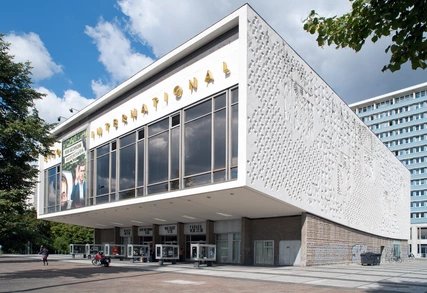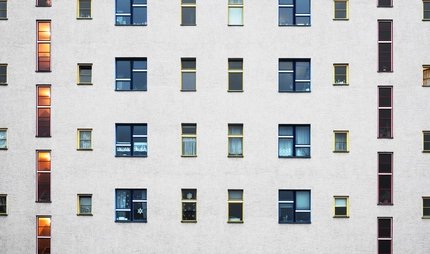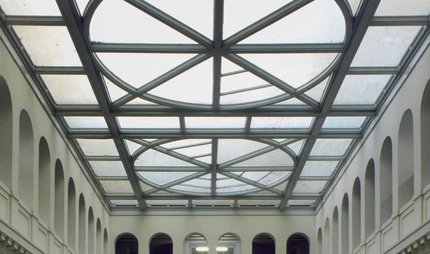
The former Stalinallee in Berlin
Palaces for the workers under socialism
Towers, columns and palaces: between Frankfurter Tor and Strausberger Platz, today's Karl-Marx-Allee, formerly Stalinallee, looks like a Russian boulevard.
Imagine yourself in Berlin at the beginning of the 1950s: the bombs of the Second World War have left Große Frankfurter Straße as nothing but a sea of rubble.
People needed housing, but it was about much more than that. The Cold War had Berlin in its grip, dividing the city into east and west. The Socialist Unity Party of Germany (SED) wanted to prove something: that the GDR had more to offer the working class than the capitalist West – not just simple apartments, but real palaces!
And the newly constructed buildings were indeed luxurious: instead of being cold, cramped and lacking hygiene, they had flats with a floor space of up to 145 square meters, with lifts, rubbish chutes, stucco ceilings, parquet floors, double glazing, doorbell systems, hot water and central heating.
But the buildings were not just meant to convey the feeling of a palace, they also had a representative function, proclaiming the supremacy of socialism.
Showcase project of the GDR
Between Frankfurter Tor and Strausberger Platz, on the street renamed Stalinallee in 1949, work on Berlin’s first major socialist prestige building project began in 1952. The thoroughfare was made unusually wide – no coincidence, because the streets of the city centre had to have enough space for civilian and military parades. The prototype was the Weberwiese tower block built in 1951/52. The chief architect of the new Stalinallee, Hermann Henselmann, set the standard for the street: well-equipped on the inside and with decorative façades on the outside.
Schinkel and classicism as a benchmark
The architects were inspired by the socialist realism and socialist classicism of the Soviet Union. Even before the Second World War, the cultural policy of the USSR had put an end to the sober, functional architecture that was characteristic of the Russian avant-garde. Schinkel and 19th-century neo-classicism were the model for the GDR, and the residential buildings designed by the architect Arkady Mordvinov in Moscow in the 1930s were the benchmark for Stalinallee. Because of its monumental ornamentation, critics ridiculed socialist classicism, calling it the wedding-cake style.
Propaganda instead of integration
On 3 February 1952, prime minister Otto Grotewohl laid the foundation stone and work started. Thousands of construction workers, including numerous volunteer helpers, put up the first brick buildings on Stalinallee. Initially, there was great enthusiasm, and many hoped to get one of the coveted apartments. The SED left nothing to chance: newspapers and posters constantly celebrated the buildings of Stalinallee. Since November 1951, people had been hearing about the reconstruction plans in the cinemas and on the radio. A film called “The New Apartment” featured the “Reconstruction Waltz”, which was often played on the radio:
Weit wie der Himmel, hell wie die Sonne schön / baun wir Häuser, schnell solln die Kräne sich drehn / Wir rufen: Hau ruck! Hau ruck! / Wir packen zu, und die Häuser erblühn / Hau ruck! Hau ruck! Für unser junges Berlin!
[High as the sky, bright as the beautiful sun / We’ll keep on building as long as the tower cranes run / We’ll call out: Heave ho! Heave ho! We’ll get stuck in, and up the buildings will go / Heave ho! Heave ho! For our new Berlin!]
But despite the propaganda, there was general dissatisfaction with the economic and political situation in the GDR. In 1952 alone, 182,000 people left the country for the West. The death of Stalin on 5 March 1953 initially changed little. To speed up the development of the GDR, the SED politburo decided in May 1953 to raise labour targets by ten percent. This decision was the last straw. People protested throughout the country, demanding not only economic improvements but also free elections and an end to SED rule.
The people’s uprising
In Berlin, workers on Block 40 of Stalinallee learned on 16 June 1953 that their colleagues building the new hospital in Friedrichshain had written a resolution against the increased labour targets. They downed tools in solidarity and marched down Stalinallee. Soon, they numbered 2,000 workers, and by the time they reached the House of Ministries on Leipziger Straße, the crowd had swelled to 10,000 people.
The rest is history: news of the demonstration spread and the protests escalated on 17 June 1953. The government reacted helplessly and Soviet troops crushed the uprising within a few hours.
The end of ornamentation
Henselmann continued construction on Stalinallee until 1958, by which time De-Stalinisation was also beginning to affect architecture. The Stalin memorial was removed, and the avenue received its current name, Karl-Marx-Allee, in 1961. The “wedding-cake” style was considered outdated. For the second construction phase between Strausberger Platz and Alexanderplatz, the authorities decided on a complete shift in building policy. Cultural buildings such as the Kosmos and Kino International and the Café Moskau were built in a functional style using industrial pre-production based on prefabricated residential building types.

Rust and decay
The flats in the former Stalinallee were still in demand, but deterioration soon set in. They became less comfortable, water pipes rusted, windows became draughty and roofs leaked. They had been put up too fast using poor quality materials in the rush to create a grand boulevard. Even in the 1950s, ceramic tiles were starting to come loose from the outer façade. By 1989, half of them had fallen off, leaving bare masonry behind, some of which the municipal housing authority concealed with temporary plastic panels.
In a historical irony, it was the end of the GDR which finally slowed down the Karl-Marx-Allee’s decay. Today the buildings on the street are listed as protected historical structures. The nearly 2,600 apartments were fully renovated in the 1990s, but this had its price: the former workers’ palaces were sold to private property funds.
Our tips for Karl-Marx Allee (formerly Stalinallee)
Along the boulevard, there are information boards describing its history. If you want to know more, you can go on a theme tour. For a very different type of historical observation in the footsteps of Homo ludens digitalis, the Computer Games Museum at Karl-Marx-Allee 93a takes you on a trip through time, dedicated to the games people play.
At Cafe Sibylle (Karl-Marx-Allee 72) you can enjoy coffee and cake, and there is also a permanent exhibition telling the café’s story from when it opened as the “Milchtrinkhalle” in 1953.
Comprehensive information on Berlin Modernist buildings and their history can be found on our website:
On Berlin Modernist Architecture
Practical information from visitBerlin
The best way to get to Karl-Max-Allee from Alexanderplatz is to take the U5 underground line. There are four stations where you can get out between Schillingstraße and Frankfurter Tor. To explore the city, we recommend the Berlin Welcome Card for public transport. Our tip is to take your time and investigate the timeline of the thoroughfare on foot or by bike.



